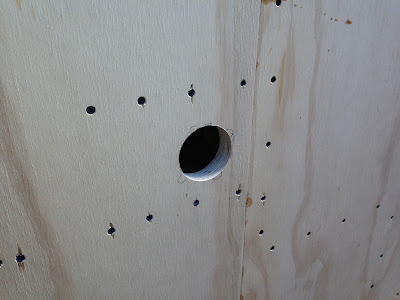With the hardware tagged and bagged, the doors, cabinet faces, and exposed wall surfaces of the camper interior and galley are sealed, stained, and varnished.
Switching gears a bit, it's time to start the electrical wiring of the trailer. Before investing much in electrical hardware, some electric design was in order. Working with a few objectives in mind, an electrical schematic diagram was really needed to guide this next phase. Fortunately, my dad came to the rescue again, sketching up what the camper electrical system would look like:
- Provide 120V AC from park power at campgrounds.
- Provide 12V DC to lights, vent fan, a water pump, electronic accessories, etc.
- Access 12V DC from automotive battery while camping (before buying a deep cycle battery).
- Access 12V DC from a deep cycle battery onboard the trailer.
- Recharge deep cycle battery from car alternator.
- Provide continuous power to 12V DC circuits via a power supply/charger while on park power.
- Recharge the deep cycle battery from the 12V power supply/while on park power.
First up is a camp extension cord and inlet. Before I could buy, I realized I didn't know what I needed. Doing some limited research, I learned that campgrounds vary according to electrical service provided. Typically, electrical service is provided and communicated according to a couple of parameters, including amperage and voltage. In the interest of avoiding a lesson in electric distribution and power (in part, because I don't know it that well), I'll keep it short here. Park power is usually provided as one (or two via, separate receptacles at the pedestal) of three options:
- 120V, 15A
- 120V, 30A
- 240V, 50A (two legs)
First up (from right to left), is a master switch to control power to everything in the camper. This is easily accomplished with a standard wall switch in its own box. Next in line is a double gang box containing two outlets, one of which provides GFCI, and the other provides surge protection. These babies are of the 20A line of Decora outlets from Leviton. Finally, a junction box is wired to enclose wire nut connections for the two additional outlets, one on the interior cabinet face, and the other on the galley cabinet face. All of these items are wired with 12/2 Romex.
The other interesting item in the picture above is the DC power supply. This beauty is a NOCO Genius 7200, and represents a transition of sorts between the AC and DC systems. The NOCO has many nice features including switchable modes and trickle/maintenance/fast charging, but almost most importantly, a 13.6V, 5A supply mode enabling continuous use of DC loads while on AC park power. Proving that this stuff all works, I couldn't help but wire it up temporarily to the vent fan for a test run:
So the window addition first requires an opening. Taking some measurements and drawing an opening using the trim ring included with the window, I cut an opening in the side of the trailer with the jigsaw.
With the opening cut, the trim ring needs to be shimmed on the back side to full wall thickness, which we have established as 1 5/8". Cutting, gluing, and nailing 1" wide shims along with adding 1/8" temporary paneling shims, the window framing takes shape.
Pairing the window on the outside with the trim ring on the inside completes the installation.
Installing the driver's door is done in a similar manner in terms of using an internal trim ring, with differences in screw length and the size/dimensions of the trim ring.
With both the door and window installed, the driver's side is starting to look finished.
Shifting to the passenger side, construction becomes a bit more complicated. Originally, I had planned to purchase two topper doors, one for each side, and as such I cut openings in the trailer accordingly. When I realized my ventilation issues, I reconsidered the topper door approach. Instead, I decided on an integrated door and screened window option from Frank Bear at Vintage Technologies/TeardropTrailerParts.com. While this door was expensive, I think it was the right choice for a clean, professional, and most importantly, dry fit and finish. Right off the bat though, I ran into a significant issue with this door- it is shorter and wider than the opening I had previously cut. Fortunately, fixing this wasn't as bad as it seemed.
Luckily, I hung onto the door blank that was cut out of the passenger opening. Cutting an approximate length off the top of this opening, we routed a groove around the door opening and the blank to enable gluing and buscuiting of the blank in place. With a few minutes of wood clamping, the opening was shrunk.
A few minutes for the glue to dry, and the opening is no longer too big. Now to make it large enough. Using the door as a stencil and aligning the lower rear corner to the existing opening, we traced the new opening, and cut with a jigsaw. A re-sized backing board helped ensure the patch stayed put, and a little bit of sanding and fitting for the trim ring, and it's installed.
Not too shabby, eh?
Whew. Ok, I'm done blogging for a few days, at least! Up next, more wiring, insulation, and paneling...




















